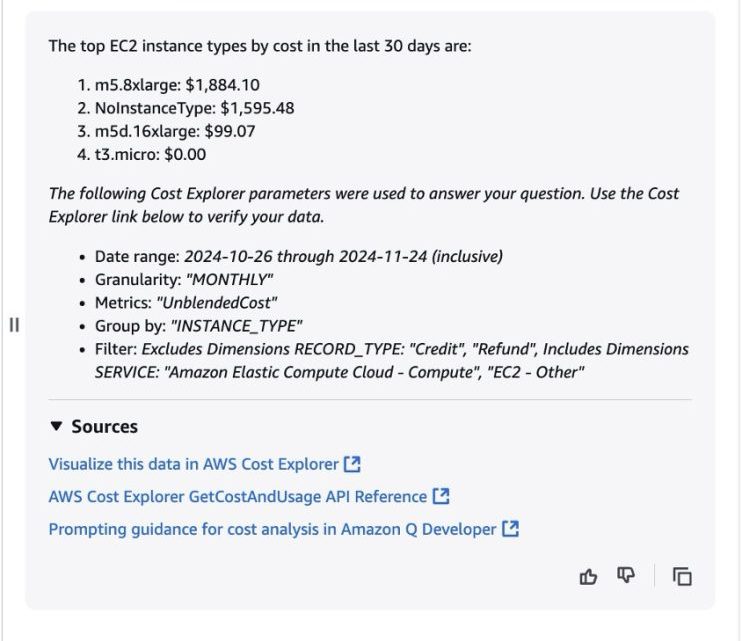
Analyzing your AWS Cost Explorer data with Amazon Q Developer: Now Generally Available
November 27, 2024We are excited to announce the general availability of the cost analysis capability in Amazon Q Developer. This powerful feature integrates Q Developer’s natural language processing capabilities with AWS Cost Explorer, revolutionizing how you analyze and understand your AWS costs. Initially launched in preview on April 30, 2024, the Amazon Q cost analysis capability now offers enhanced functionality, allowing users to gain deeper insights into their cloud spending through simple, conversational interactions.
In this blog, we will highlight the key features and capabilities of analyzing your Cost Explorer data with Amazon Q Developer, including its ability to handle complex cost queries, provide context-aware responses, and offer actionable insights into your AWS spending.
Simplifying Cost Analysis with Natural Language Queries
At the heart of Amazon Q for AWS cost management is its ability to understand and respond to natural language queries. This feature reduces the learning curve to get valuable cost insights from Cost Explorer.
Users can now simply type their questions in plain English, such as:
- “What were my top 5 most expensive services last month?”
- “How much did my S3 costs increase between Q1 and Q2?”
- “Did we receive any credits last quarter, and if so, how much?”
Q Developer interprets these questions, processes the relevant data, and provides detailed, actionable insights.
For our first example, imagine you’re a Cloud Architect who wants to understand the cost implications of recent architectural changes. You could open Amazon Q in the AWS Management Console and enter a prompt such as: “Show me the breakdown of EC2 costs by instance type for the last 30 days”

Figure 1: Q Developer listing breakdown of EC2 instance types for a specific time period
As shown in Figure 1, Q Developer provides a detailed breakdown of the EC2 instance types for the last 30 days.
Let’s consider another scenario. A FinOps professional responsible for reporting on cloud costs across multiple departments could ask “What were last month’s costs broken down by Cost Category “Cost Center”?

Figure 2: Q Developer delivers a comprehensive cost analysis breakdown by cost category for the previous month.
Figure 2 showcases Q Developer’s capability to instantly generate detailed cost insights based on custom categories. This feature empowers users to make data-driven decisions for more effective cost allocation and budget planning.
Finally, let’s say you are an IT professional who wants to understand what your future costs will look like, based on current workloads and recent trends. You could ask “What are my forecasted costs for Q1 of next year?”

Figure 3: Q Developer provides forecasted cost data from AWS Cost Explorer.
Figure 3 shows Q Developer ’s ability to provide both historical and forecasted costs, helping customers plan and predict their spending.
Here are some other examples of questions you can now explore when analyzing your Cost Explorer data with Amazon Q:
- What percentage of our total costs last month were attributed to tag key = “Environment”, value = “Dev”?
- Which services had the highest month-over-month cost increase in September?“
- Which linked accounts spent the most last month?
- What is our forecasted spend for the next three months?
- What were my costs broken down by tag key “Project”?”
Verifying data and diving deeper
Q Developer provides transparency on the specific AWS Cost Explorer parameters that were used to retrieve the data to answer your questions. This transparency allows you to verify that the data presented is exactly what you were looking for. Additionally, each response includes a link to a matching view in AWS Cost Explorer, so you can dive deeper and visualize your data.

Figure 4: Q Developer provides a link to a matching view in AWS Cost Explorer.
Figure 4 demonstrates how Q Developer bridges natural language queries with AWS Cost Explorer’s powerful visualization capabilities. This integration allows users to effortlessly transition from conversational insights to comprehensive graphical representations of their cost data, facilitating more thorough analysis and informed decision-making.
Conclusion
The general availability of Q Developer for AWS Cost Management marks a significant milestone in simplifying cloud financial management. By leveraging natural language processing and context-aware responses, Amazon Q makes it easier than ever for users across various roles – from FinOps professionals to application developers– to gain valuable insights into their AWS spending.
These new features streamline the process of cost analysis and forecasting, improving efficiency and enabling data-driven decision-making for AWS users. We encourage you to explore Amazon Q for cost analysis and experience firsthand how it can transform your approach to cloud cost management.
To get started with cost analysis in Q Developer, simply log in to the AWS Management Console and click on Amazon Q icon on the right side of the console. For more information on pricing and availability, please visit our Cost analysis in Amazon Q Developer documentation.
